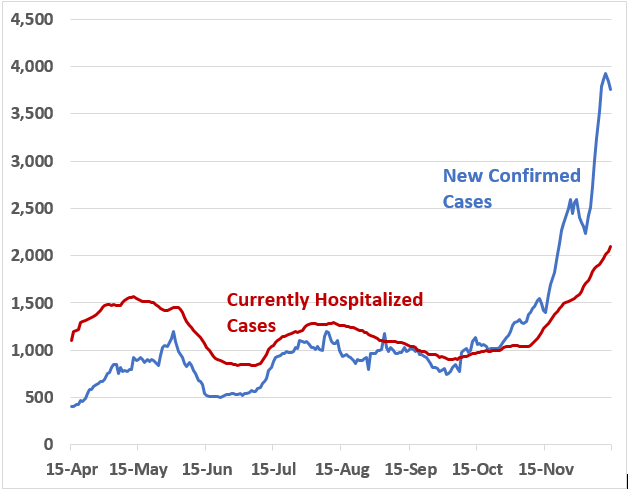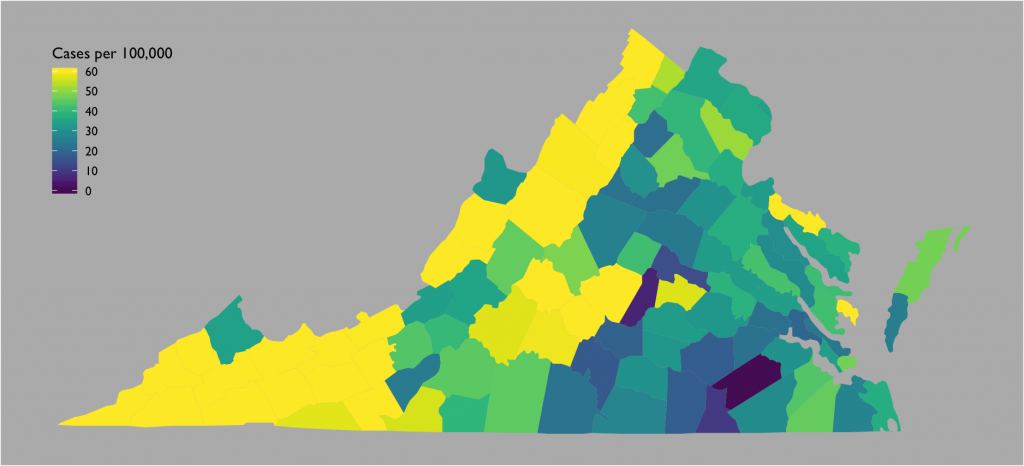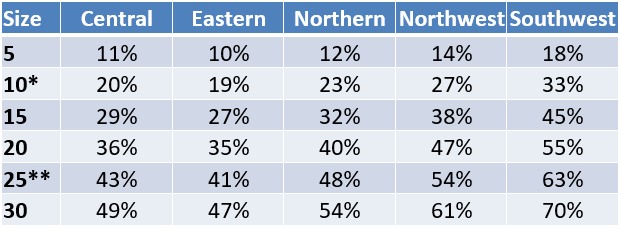By Carter C. Price
Virginia is averaging more than 3,500 confirmed cases of COVID-19 per day (more than 40 cases per 100,000) over the last few weeks. This case rate is the highest we have seen since the first case was announced in Virginia in March. Further, it is more than four times the levels we saw during this summer’s surge, as can be seen in Figure 1. Hospitalizations have also been increasing and trail behind the case level by about two or three weeks. Just as cases increased rapidly after the Thanksgiving weekend, holiday gatherings in the coming weeks could push levels even higher. It has never been more important to limit the size of gatherings this holiday season, not only to protect those gathering but to keep hospital beds open for all who might need them.

Source: https://covidtracking.com/data/state/virginia
Figure 2 shows the average daily cases per 100,000 by county from December 8 to 15. Most counties in the Southwest and many counties in the Northwest and Central regions have daily cases rates well above 60 per 100,000. However, just about every county in Virginia has high rates of COVID-19, over 20 per 100,000.

Source: VDH
When case rates are this high, the risk from even small gatherings of people outside of one’s household increases substantially. As seen in Table 1, we used regional COVID-19 prevalence to estimate the risk that at least one person will show up to a holiday gathering infected with COVID-19 depending on the number of attendees. Some gatherings will face higher risk of being exposed to the virus than these estimates because of the presence of people with occupations or behaviors that raise their risk of being infected by COVID-19. Other gatherings, such as those involving a couple of families that have been social distancing, may face lower risks of exposure.

Note: * Current limit on social gathering and **Previous limit on social gathering
Source: Author’s calculations using a binomial distribution where attendees are independently sampled with probability of infections based on the 14-day infectious period and assuming one-fourth of infections are confirmed by testing.
In the Southwest, more than half of events with 20 people would be expected to have at least one attendee with COVID-19. The odds are only slightly lower for most of the rest of the Commonwealth. Even small gatherings come with risks. For gatherings with just ten people, the current limit on social gathering size, we expect about one in five in Central and Eastern Virginia to include at least one person with COVID-19; that increases to about one in four in Northern and Northwest Virginia. In Southwest Virginia, we expect about one in three gatherings of ten people will include at least one person with COVID-19. Given that case rates are expected to continue to grow, the risks will be even higher by the end of this week.
Governor Northam’s Executive Order Seventy-Two lowered the limit on social gatherings to 10 people from 25. If followed, this lower limit will cut the risk of spread from a gathering of the maximum allowed size nearly in half across the Commonwealth, but even at this lower level, the likelihood that an attendee at a gathering has COVID-19 is still sizable, ranging from one-in-five to one-in-three. That is why it is important to continue to follow the guidance from VDH and the CDC regarding safe gatherings.
Just as cases increased after Thanksgiving weekend in much of Virginia, Christmas, New Years, and other holiday gatherings could lead to increased COVID-19 spread. If that happens, we’ll see cases rise rapidly during the first two weeks of January, hospitalizations will rise shortly after that, and by the end of January the number of deaths per day from COVID-19 will be substantially higher than today. January and February could be quite grim if what follows this holiday season is similar to the spread of disease after Thanksgiving weekend.
